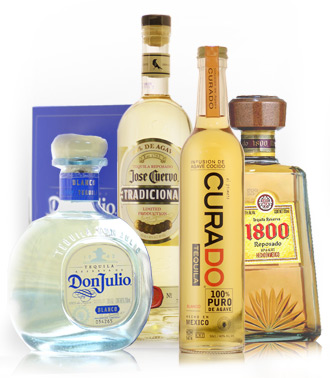Tequila - Heart & Soul of Mexico

Text partly taken from Ian Chadwick's comprehensive Tequila pages.
Tequila is a product of the arid highlands of central Mexico, fermented and distilled from the sap of the indigenous Agave plant. It is North America's first distilled drink and its first commercially produced alcohol with an ancestory reaching back into pre-Hispanic times: Archeologists believe the agave to have been cultivated for at least 9,000 years with natives fermenting its sap into a drink called 'pulque' - the pre-cursor to modern Tequila.
Others take a more romantic approach to Tequila's genealogy. In the book "Tequila: Panegyric and Emblem", the Mexican poet, Alvaro Mutis muses:
"Tequila has no history; there are no anecdotes confirming its birth.
This is how it's been since the beginning of time, for tequila is a gift from the gods and they don't tend to offer fables when bestowing favors. That is the job of mortals, the children of panic and tradition".
The subsequent history of tequila's development from a traditional beverage to the modern spirit of today very much parallels the growth of Mexico herself.In the 400 years following the Spanish Conquest, Tequila has become an icon of Mexican pride and culture. It is recognized worldwide, yet transcends simple definitions. As Carmelita Roman, widow of the late Tequila producer Jesus Lopez Roman observed, "Tequila is Mexico...It's the only product that identifies us as a culture."
Today, most Tequila is made in Jalisco state around the town of Tequila, with nearly 200 million litres sold worldwide annually. Production remains limited by the availability of Blue Agave, and consequently prices have soared in recent years due to unprecented demand. Despite its popularity, no other drink remains surrounded by as many myths or as much confusion as tequila and its companion, Mezcal. We seek to dispel some of the mystification in the following pages, but to begin with, it is important to recognise the distinction between the two spirits. Mezcal is produced from different species of Agave plant, and is also the older form of the name for 'Tequila' - a name only adopted in the late 19th century. Technically, all Tequilas are Mezcals, which were also known as 'mezcal wines' and 'mezcal brandies' before the name Tequila became common. Today Mezcal & Tequila are seen as distinct products, differentiated by production processes and taste, in much the same way American Rye Whiskey and Scotch Malt Whisky are cousins rather than brothers.
Differentiating Mezcal from Tequila
Unlike tequila, mezcal has remained closer to its origins as a drink of villagers and artisan producers, persisting with tradition, as only mezcal can be made. It differentiates itself from tequila by a countrified approach taken by the distillers in the Oaxaca region (pronounced 'wa-ha-ka') who today produce around 60% of the total Mezcal output. It achieved Denominacion de Origen status in 2005. Unlike tequila, which employs only the Weber variety from fields around Jalisco, there are eleven types of agave, collectively known as ‘Maguey’ which are permitted in mezcal, such as the widely cultivated ‘Espadin’ or ‘Manso’ varieties and the more sought after wild ‘Tobala’ - the trophy of the mezcal world. Unlike tequila, mezcal is required to be at least 80% pure blue agave (tequila only 51%).
As awareness for mezcal has slowly grown, commercial opportunities have been harnessed. Keeping pace with demand (which remains insignificant in comparison to tequila), it’s now been made on a more industrial scale too. This has led to some bottlers adding cane alcohol, caramel, colour, sulphates, sweetener and even fertiliser, usually in order to speed up output. Drinking this stuff is like following cheap tequila down a dirty track towards an unforgettably brutal hangover. Don’t consider a worm in the bottle a sign of authenticity or quality either. Real mezcal is of another dimension, and it’s not easy to come by.
Even now, the only place to sample real Mezcal generally involves a trip to Oaxaca, and then out of town. Away from the big city is where its production remains rustic and unhurried. Initially the process resembles the manner in which primitive tribes cooked food in holes: Agave hearts are cooked in a conical pit in the ground. Stone and charcoal are heated in it and the agaves laid on top, covered with palm leaves, matting and soil, cooked for three to five days, taking on the aromas of smoke and earth. Left to cool for a week, wild fermentation begins following which the baked agaves are crushed. This often happens using horse driven millstones. The pulp is mixed with water and fermentation is completed in large vats. Rather humble copper or clay kettle stills are employed, wood-fired, and rarely more than 100 litres in capacity. Double distillation is the norm. Maturation may range anywhere between one month to over a decade.
One has to search for artisanal examples of this exotic spirit. That’s just what modern day mezcal pioneer and founder of 'Del Maguey', Ron Cooper did. His conversion came about while looking for the best tasting mezcal to Christen a new sculpture with (Cooper is an established American artist). The Oaxaca locals pointed him towards the mountains. In the remote villages and foothills he discovered mezcals that tasted nothing like the ‘rot-gut’ so infamous in the Mexican cities. Yet, as Cooper realised, most people have no idea that these sorts of mezcals exist.
These mezcals can vary in taste as much as wines, and flavour wise, there’s virtually nothing like them in the world. Perhaps their only natural counterpart is smoky Islay Scotch (interestingly, Japan is one of mezcal's biggest export markets). Indeed, the relationship between mezcal and tequila has been equated to that of Islay malts vs the rest of the whisky world – exotic, assertive, smoky, briny even ‘industrial’ at times – that’s real mezcal.
